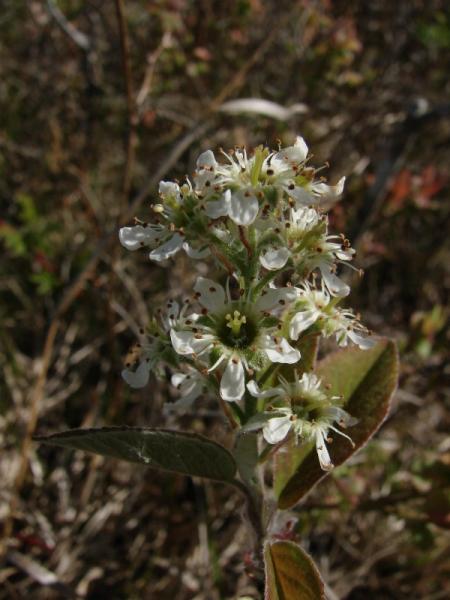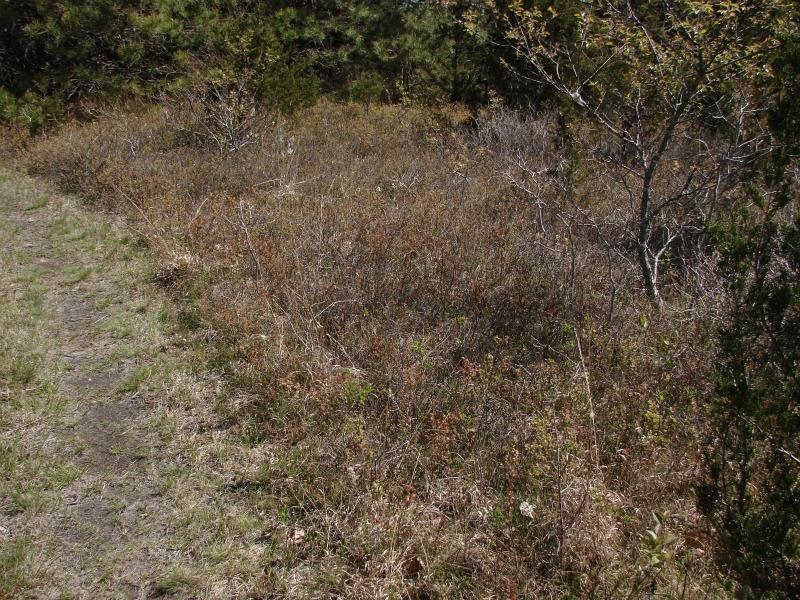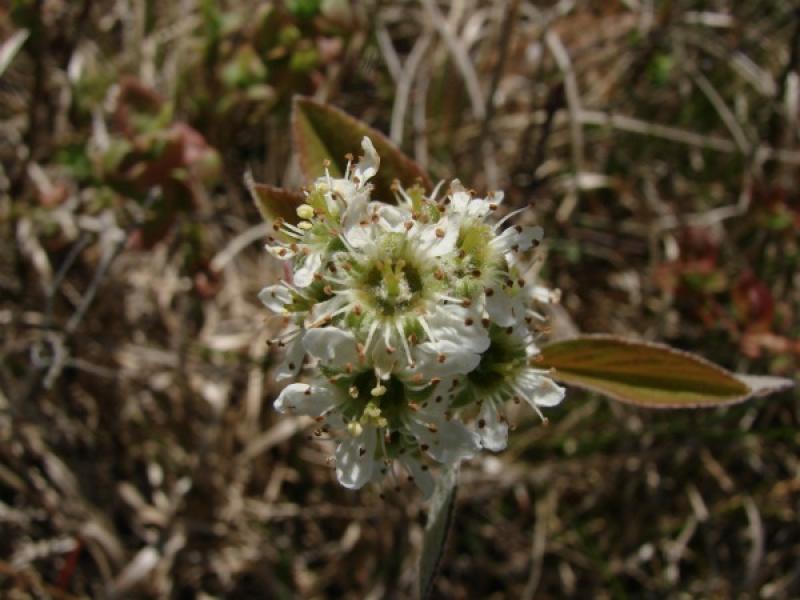Nantucket Juneberry
Amelanchier nantucketensis Bickn.
- Class
- Dicotyledoneae (Dicots)
- Family
- Rosaceae (Rose Family)
- State Protection
- Endangered
Listed as Endangered by New York State: in imminent danger of extirpation in New York. For animals, taking, importation, transportation, or possession is prohibited, except under license or permit. For plants, removal or damage without the consent of the landowner is prohibited.
- Federal Protection
- Not Listed
- State Conservation Status Rank
- S1
Critically Imperiled in New York - Especially vulnerable to disappearing from New York due to extreme rarity or other factors; typically 5 or fewer populations or locations in New York, very few individuals, very restricted range, very few remaining acres (or miles of stream), and/or very steep declines.
- Global Conservation Status Rank
- G3Q
Vulnerable globally - At moderate risk of extinction due to rarity or other factors; typically 80 or fewer populations or locations in the world, few individuals, restricted range, few remaining acres (or miles of stream), and/or recent and widespread declines. The Q indicates this species' status as a distinct full species is uncertain.
Summary
Did you know?
This is the only juneberry in New York with flowers that produce pollen on the edges of the petals. It was first described from plants on Nantucket Island in Massachusetts by botanist Eugene Bicknell in 1911 (Bicknell 1911).
State Ranking Justification
There are three known populations on Long Island and one on Staten Island that is under threat. The largest population has about 200 plants. There is one additional old record at Montauk Point that has not been surveyed.
Short-term Trends
The short-term trend seems stable on Long Island, but the plants are under threat, if not extirpated, on Staten Island because of building construction.
Long-term Trends
The long-term trend is probably stable on Long Island, because almost all populations are in protected areas, even though they are subject to occasional destructive disturbance along a power line at one site. The 2 small populations on Staten Island have declined and may be gone.
Conservation and Management
Threats
On Staten Island the development of a hotel complex has threatened the plants. On Long Island there are plants along a powerline right-of-way and a railroad that are occasionally subject to destructive disturbance when there is maintenance of the right-of-ways.
Conservation Strategies and Management Practices
Maintain a buffer around plants to prevent direct destruction or poisoning from herbicides. Maintain succession in an early stage to prevent competition from larger shrubs and trees.
Research Needs
More research is needed to document the range of flower and vegetative variability of the plants on Long Island.
Habitat
Habitat
In New York, Nantucket Juneberry grows on sandy soils in a variety of coastal habitats. It has been found growing alongside maritime grasses, in shrubby, heath-dominated areas, and with oaks and pitch pines in woodlands and forest openings (New York Natural Heritage Program 2009). Dry, open areas (Haines 1998). Dry moors, pine-barrens and pond margins (Fernald 1970).
Associated Ecological Communities
- Maritime beech forest
(guide)
A hardwood forest with American beech as a dominant that usually occurs on north-facing exposed bluffs and the back portions of rolling dunes in well-drained fine sands. Wind and salt spray cause the trees to be stunted (average height 4 m to 15 m) and multiple-stemmed with contorted branches, especially on the exposed bluffs.
- Maritime grassland
(guide)
A grassland community that occurs on rolling outwash plains of the glaciated portion of the Atlantic coastal plain, near the ocean and within the influence of offshore winds and salt spray.
- Maritime heathland
(guide)
A dwarf shrubland community that occurs on rolling outwash plains and moraine of the glaciated portion of the Atlantic coastal plain, near the ocean and within the influence of onshore winds and salt spray.
- Maritime pitch pine dune woodland*
(guide)
A maritime woodland that occurs on stabilized parabolic dunes. The substrate is wind and wave deposited sand that is usually excessively well-drained and nutrient poor. The community is subject to high winds, sand-blasting, salt spray, and shifting substrate.
- Maritime post oak forest
(guide)
An oak-dominated forest that borders salt marshes or occurs on exposed bluffs and sand spits within about 200 meters of the seacoast. The trees may be somewhat stunted and flat-topped from pruning by salt spray and wind exposure. The forest is usually dominated by two or more species of oaks, including post oak, black oak, scarlet oak, and white oak.
- Maritime red cedar forest*
(guide)
A conifer forest that occurs on dry sites near the ocean. Eastern red cedar is the dominant tree, often forming nearly pure stands. Other characteristic trees include post oak and black cherry.
- Maritime shrubland*
(guide)
A shrubland community that occurs on dry seaside bluffs and headlands that are exposed to offshore winds and salt spray.
- Pitch pine-oak-heath woodland
(guide)
A pine barrens community that occurs on well-drained, infertile, sandy soils. The structure of this community is intermediate between a shrub-savanna and a woodland. Pitch pine and white oak are the most abundant trees.
* probable association but not confirmed.
Associated Species
- Amelanchier spicata (dwarf shadbush)
- Andropogon scoparius
- Arctostaphylos uva-ursi (bearberry)
- Carex pensylvanica (Pennsylvania sedge)
- Cyperus filicinus (fern flat sedge)
- Danthonia spicata (poverty grass)
- Deschampsia flexuosa
- Gaylussacia baccata (black huckleberry)
- Helianthemum dumosum
- Hieracium gronovii (beaked hawkweed)
- Lechea maritima
- Myrica gale (sweet gale)
- Prunus maritima (beach plum)
- Quercus alba (white oak)
- Quercus stellata (post oak)
- Rhus copallinum
- Rubus allegheniensis (common blackberry)
- Schizachyrium scoparium
- Vaccinium
Range
New York State Distribution
This shrub is known from the South Fork of Long Island where it is very local, and from a small area of Staten Island that is under pressure from development.
Global Distribution
Amelanchier nantucketensis has a small range, with most occurrences on Nantucket and Martha's Vineyard Islands, Massachusetts; and a few additional sites on Long Island and Staten Island, New York; at Great Falls, Maryland; and in Maine and Nova Scotia.
Identification Comments
General Description
Nantucket Juneberry is a colonial shrub, growing up to 2.5 meters (but usually much shorter, up to knee height), often with many stems growing close together. At flowering time, the leaves are still partially folded lengthwise and hairy underneath. The inflorescences are erect racemes of 7 to 10 flowers. The petals are white, spoon-shaped, 3-4 mm long (short for NY Amelanchier species), and have the unusual characteristic known as andropetaly, meaning that some of the petals produce pollen (FNA 2008). Flowering stems are needed to positively identify Nantucket Juneberry.
Best Life Stage for Proper Identification
Nantucket Juneberry can only be positively identified when flowering.
Similar Species
Amelanchier nantucketensis was previously considered a hybrid between A. canadensis and A. spicata. Both of those species are taller and have larger petals which do not produce pollen. Amelanchier stolonifera is the species that most looks like A. nantucketensis. It is short but usually above knee height and the petals are oblong or narrowly obovate, 7-9 mm long and without pollen sacs. It is impossible to definitively distinguish the two species when not in flower.
Best Time to See
Flowers open the first to second week of May and fruits persist to mid-summer. Must be identified while flowering.
- Flowering
The time of year you would expect to find Nantucket Juneberry flowering in New York.
Nantucket Juneberry Images
Images of Similar Species
Taxonomy
Nantucket Juneberry
Amelanchier nantucketensis Bickn.
- Kingdom Plantae
- Phylum Anthophyta
- Class Dicotyledoneae
(Dicots)
- Order Rosales
- Family Rosaceae (Rose Family)
- Order Rosales
- Class Dicotyledoneae
(Dicots)
- Phylum Anthophyta
Synonyms
- Amelanchier x nantucketensis Bickn. [= A. canadensis x stolonifera]
Additional Resources
Best Identification Reference
Haines, Arthur and Thomas F. Vining. 1998. Flora of Maine. A Manual for Identification of Native and Naturalized Vascular Plants of Maine.
Other References
Bicknell, Eugene P. 1911. The ferns and flowering plants of Nantucket-VIII. Bulletin of the Torrey Botanical Club 38 (10): 447-460.
Crow, Garrett E. 1982. New England's Rare, Threatened, and Endangered Plants. Prepared for the United States Department of Interior, Fish and Wildlife Service, Northeast Region. June 1982.
Dibble, Alison C. and Christopher S. Campbell. 1995. Distribution and conservation of Nantucket shadbush, Amelanchier nantucketensis (Rosaceae). Rhodora 97(892): 39-349.
Dibble, Alison C. and Francis A. Drummond. 1997. Floral syndrome in Amelanchier nantucketensis (Rosaceae). 1. Floral density, bee activity, and characterization of andropetaly.
Fernald, M. L. 1950. Gray's manual of botany. 8th edition. Corrected printing (1970). D. Van Nostrand Company, New York. 1632 pp.
Gleason, Henry A. and A. Cronquist. 1991. Manual of Vascular Plants of Northeastern United States and Adjacent Canada. The New York Botanical Garden, Bronx, New York. 910 pp.
Holmgren, Noel. 1998. The Illustrated Companion to Gleason and Cronquist's Manual. Illustrations of the Vascular Plants of Northeastern United States and Adjacent Canada. The New York Botanical Garden, Bronx, New York.
Mitchell, Richard S. and Gordon C. Tucker. 1997. Revised Checklist of New York State Plants. Contributions to a Flora of New York State. Checklist IV. Bulletin No. 490. New York State Museum. Albany, NY. 400 pp.
New York Natural Heritage Program. 2010. Biotics database. New York Natural Heritage Program. New York State Department of Environmental Conservation. Albany, NY.
New York Natural Heritage Program. 2024. New York Natural Heritage Program Databases. Albany, NY.
Reschke, Carol. 1990. Ecological communities of New York State. New York Natural Heritage Program, New York State Department of Environmental Conservation. Latham, NY. 96 pp. plus xi.
Seymour, F.C. 1989. The flora of New England. A manual for the identification of all vascular plants including ferns and their allies growing without cultivation in New England. Boston Museum Science, Boston. 611 pp. + appendix.
Weldy, T. and D. Werier. 2010. New York flora atlas. [S.M. Landry, K.N. Campbell, and L.D. Mabe (original application development), Florida Center for Community Design and Research http://www.fccdr.usf.edu/. University of South Florida http://www.usf.edu/]. New York Flora Association http://newyork.plantatlas.usf.edu/, Albany, New York
Links
About This Guide
This guide was authored by: Stephen M. Young
Information for this guide was last updated on: April 11, 2011
Please cite this page as:
New York Natural Heritage Program. 2024.
Online Conservation Guide for
Amelanchier nantucketensis.
Available from: https://guides.nynhp.org/nantucket-juneberry/.
Accessed July 26, 2024.



